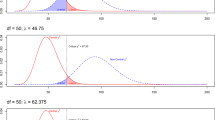Abstract
We treat the Bayesian prediction problem in growth-curve models with correlated errors when the underlying model is hierarchical. We assume there to be data on several individuals randomly drawn from the same population. For each individual, several responses are available that arise from a lincar model with autocorrelated errors. The regression parameters for the individuals are modeled to arise from a multivariate normal distribution. We investigate two prediction problems, (a) where another individual is randomly drawn from the same population and we want to predict several responses for this individual, and (b) where we want to predict additional responses for one of the individuals in our sample. A detailed numerical example is given; calibration is discussed in the context of this example.
Similar content being viewed by others
References
Aitchison, J., and I.R. Dunsmore (1975).Statistical Prediction Analysis. Cambridge University Press, Cambridge.
Barry, D. (1995). A Bayesian model for growth curve analysis.Biometrics,51, 639–655.
Box, G.E.P., G.M. Jenkins, and G.C. Beinsel (1994).Time Series Analysis: Forecasting and Control, third edition. Prentice Hall, Englewood Cliffs, N.J..
Chib, S. (1993). Bayes regression with autoregressive errors: a Gibbs sampling approach.Journal of Econometrics,58, 275–294.
Fearn, T. (1975). A Bayesian approach to growth curves.Biometrika,62, 89–100.
Geisser, S. (1980). Growth curve analysis, inHandbook of Statistics (P.R. Krishnaiah ed.) North-Holland, Amsterdam, 89–115.
Gelfand, A.E., and A.F.M. Smith (1990). Sampling based approaches to calculating marginal densities.Journal of the American Statistical Association,85, 398–409.
Glasbey, C.A. (1979). Correlated residuals in non-linear regression applied to growth data.Applied Statistics,28, 252–259.
Guttman, I., and U. Menzefricke (1996). Predictive distributions in the presence of measurement errors.Probability in the Engineering and Informational Sciences,10, 601–611.
Hobert, J.P., and G. Casella (1996). The effect of improper priors on Gibbs sampling in hierarchical linear mixed models.Journal of the American Statistical Association,91, 1461–1473.
Keramidas, E.M., and J.C. Lee (1990). Forecasting technological substitutions with concurrent short time series.Journal of the American Statistical Association,85, 625–632.
Lee, J.C. (1988). Prediction and estimation of growth curves with special covariance structures.Journal of the American Statistical Association,83, 432–440.
Lindley, D.V., and A.F.M. Smith (1972). Bayes estimates for the linear model.Journal of the Royal Statistical Society, B,34, 1–41.
Liski, E.P., and T. Nummi (1996). Prediction in repeated-measures models with engineering applications.Technometrics,38, 25–36.
Odell, P.L., and A.H. Feiveson (1966). A numerical procedure to generate a sample covariance matrix.Journal of the American Statistical Association,61, 199–203.
Palmer, J.L., and L.I. Pettit (1996). Risks of using improper priors with Gibbs sampling and autocorrelated errors.Journal of Computational and Graphical Statistics,5, 245–249.
Palmer, M.J., B.F. Phillips, and G.T. Smith (1991). Application of nonlinear models with random coefficients to growth data.Biometrics,47, 623–635.
Potthoff, R.F., and S.N. Roy (1964). A generalized multivariate analysis of variance model useful especially for growth curve problems.Biometrika,51, 313–326.
Ritter, C., and M.A. Tanner (1992). The Gibbs stopper and the griddy Gibbs sampler.Journal of the American Statistical Association,87, 861–868.
Roberts, G.O., and S.K. Sahu (1997). Updating schemes, correlation structure, blocking and parameterization for the Gibbs Sampler.Journal of the Royal Statistical Society, B,59, 291–317.
Tanner, M.A. (1993).Tools for Statistical Inference: Methods for the Exploration of Posterior Distributions and Likelihood Functions, second edition. Springer-Verlag, New York.
Timm, N.H. (1980). Multivariate Analysis of Variance of Repeated Measurements, inHandbook of Statistics (P.R. Krishnaiah ed.) North-Holland, Amsterdam, 41–87.
Author information
Authors and Affiliations
Corresponding author
Rights and permissions
About this article
Cite this article
Menzefricke, U. Bayesian prediction in growth-curve models with correlated errors. Test 8, 75–93 (1999). https://doi.org/10.1007/BF02595863
Received:
Accepted:
Issue Date:
DOI: https://doi.org/10.1007/BF02595863
Key Words
- Autoregressive model
- calibration
- correlated errors
- Gibbs sampling
- growth curves
- hicrarchical model
- inverse prediction
- panel data
- prediction




